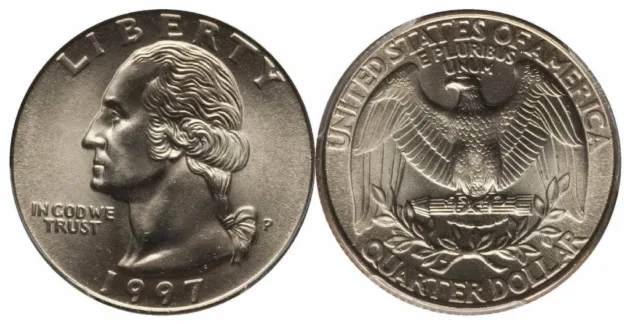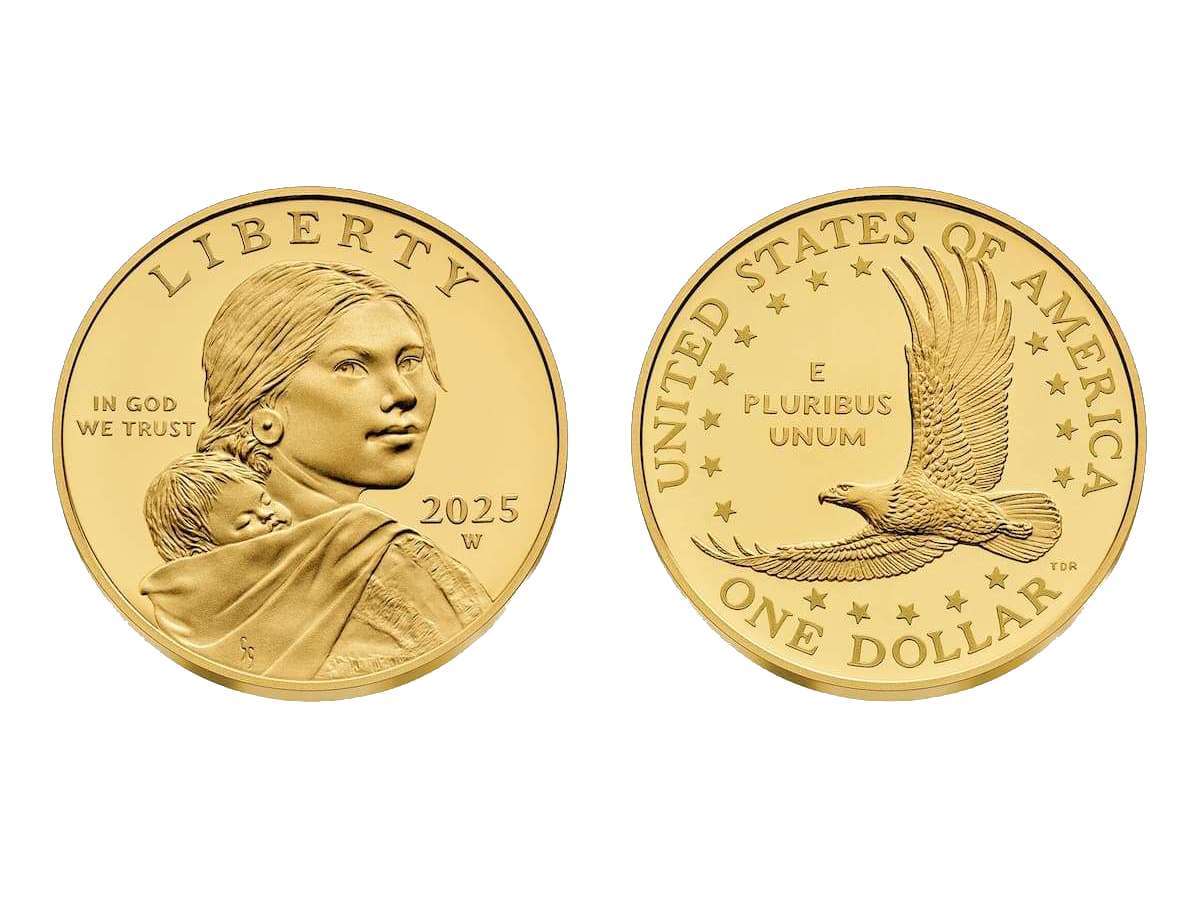Believe it or not, some 1997 Washington quarters are worth a lot more than their face value!
You’ve just got to know which 1997 quarters are rare and valuable and which ones you can safely spend.
Wondering how to tell the difference?
In this article I’m going to clearly explain the details you should be looking for on a 1997 quarter — in order to determine if it’s rare and valuable or not.
Today you will learn exactly which 1997 quarters you should be saving and why these old quarters are worth so much money today!
First, Some Fun Facts About The 1997 Quarter

John Flanagan designed the Washington quarter in 1932, using a bust portrait of the first United States president on the obverse (“heads side”) of the coin and a heraldic eagle on the reverse (“tails side”).
This design pairing was seen on the Washington quarter until 1999 — when the 50 State Quarters program was launched.
Where is the mintmark on a 1997 quarter?
Every 1997 quarter has a mintmark (a mint letter stamp) that indicates where the coin was struck.
In the case of 1997 quarters, you will find one of three possible mintmarks:
- P = Philadelphia Mint
- D = Denver Mint
- S = San Francisco Mint
You will find the mintmark on the right side of the obverse, behind (to your right of) the bow in Washington’s ponytail.
Are there any 1997 silver quarters?
The good news is YES, there are some valuable silver 1997 quarters worth looking for.
The not-so-good news… You probably won’t be finding any 1997 silver quarters in everyday pocket change.
The reason 1997 silver quarters aren’t turning up in spare change is that they weren’t made for circulation. They were struck only for collectors and sold in special packaging — and the truth is relatively few of them have ever been broken out of their packages and spent as money.
We will delve into this more a bit later in this article. For now, just know that the key to looking for these old silver quarters worth money is to search for 1997 quarters with an “S” mintmark. The 1997-S quarters you want are the ones that are a bit heavier than the regular 1997 clad quarters.
How much should a 1997 quarter weigh?
There are two kinds of 1997 quarters: clad 1997 quarters and silver 1997 quarters.
Here’s how much they should each weigh:
- Clad — 5.67 grams
- Silver — 6.25 grams
Need a coin scale? These are the best scales for weighing U.S. coins.
Something to keep in mind when you’re weighing coins is that not all quarters weigh exactly those amounts. The U.S. government provides some leniency in these standard weights with tolerances. That’s the amount — more or less — a coin can weigh and still be considered a legal U.S. coin.
For quarters, the tolerances are:
- Clad — Up to 0.227 grams over or under
- Silver — Up to 0.195 grams over or under
That means an uncirculated 1997 clad quarter might weigh as little 5.44 grams or as much 5.90 grams. Conversely, a new 1997-S silver quarter could come in anywhere between 6.05 grams and 6.45 grams. Bear in mind, too, that worn (circulated) quarters may weigh even less than these figures due to loss of metal through circulation and post-mint damage.
TIP: This would also be a good time to grab a coin magnifier and a copy of the U.S. Coin Grading Standards book. These are the two best tools that will help you determine the value of all your U.S. coins.
Are 1997 quarters rare?
While the vast majority of 1997 quarters are common and worth only face value, some are rare — due to their condition or the presence of errors and/or varieties. Those are the ones that are worth a lot of money, and we’re going to talk about those rare and valuable 1997 quarters next!
How Much Is A 1997 Quarter Worth Today?
1997-P Quarter Value
The 1997-P quarter saw a mintage of 595,740,000!
Even though the Philadelphia Mint cranked out more than a half billion 1997 quarters, most are worth only face value of 25 cents — if circulated.
A typical uncirculated 1997-P quarter is worth $1 to $3.
The most valuable 1997-P quarter was graded by Professional Coin Grading Service in Mint State-67+ and fetched an astounding $3,525 in a 2016 auction.
1997-D Quarter Value
The Denver Mint produced 599,680,000 quarters in 1997, making it about as common its Philly counterpart from the same year.
Similarly, a typical worn 1997-D quarter is worth its face value of 25 cents, though some examples are worth more.
Most uncirculated 1997-D quarters are worth between $1 and $3.
The most valuable 1997-D quarter was graded Mint State-68 by Professional Coin Grading Service and sold for an impressive $977.50.
1997-S Quarter Value
As for those 1997-S quarters you’ll likely have a very difficult time finding in pocket change?…
Well, for one, they were all made at the San Francisco Mint and sold in sets directly to collectors. Thus, they were never distributed into circulation by the United States Mint.
What makes these 1997-S quarters special, aside from being issued only for collectors, is that they were produced as proofs. A proof coin is made using highly polished planchets (a blank ready for striking) that were struck by specially prepared dies on high-tonnage presses — ensuring that even the most minute details are fully rendered.
The 1997-S proof clad quarter saw a mintage of 2,055,000 and has a typical value of $3 to $5 apiece. The most valuable 1997-S clad quarter was graded Proof-70 Deep Cameo by Professional Coin Grading Service and sold for $718.75 in a 2003 auction.
The silver 1997-S proof quarter was struck to the tune of 741,678 pieces and has a value in the range of $5 to $10. The most valuable 1997-S silver quarter was graded Proof-70 Deep Cameo and sold for $494.50 in a 2003 auction.
A List Of 1997 Quarter Errors To Look For
As many collectors know, varieties and error coins can be worth a lot of money! So, it’s natural to think that any 1997 quarters you find with unusual markings or other oddities are probably worth a lot of cash.
But the reality is that the majority of weird-looking things you may find on a coin are usually not errors or varieties — they’re just post-mint damage. Remember why errors and varieties are valuable: because they’re rare and hard to find!
Still, you should keep your eyes peeled for 1997 error quarters worth money.
Here’s a short list of a few that can bring you big bucks:
- 1997 quarter struck on dime planchet — One example of this fascinating error sold at auction for $690 in 2021. Similar 1997 quarter errors often trade for $200 to more than $700. (Here’s more about wrong planchet errors.)
- 1997 clipped planchet — Clipped planchet errors are made in the blanking process, when the round pieces of metal used to make a coin are being cut from long sheets of metal. These 1997 quarter errors can be worth anywhere from $25 to $50 or more. One such error coin sold for $36 in 2011.
- 1997 off-center error — Off center errors are wildcard errors that can be worth any range of prices. The values are contingent upon how much of the design is missing and what parts are still visible. A rare type of off-center error is about 50% off center but still shows a complete date — such 1997 quarter errors are capable of taking $500. Most 1997 quarter off-center errors are worth $20 to $50. One such piece that was about 10% off center, sold for $34 in 2022.




